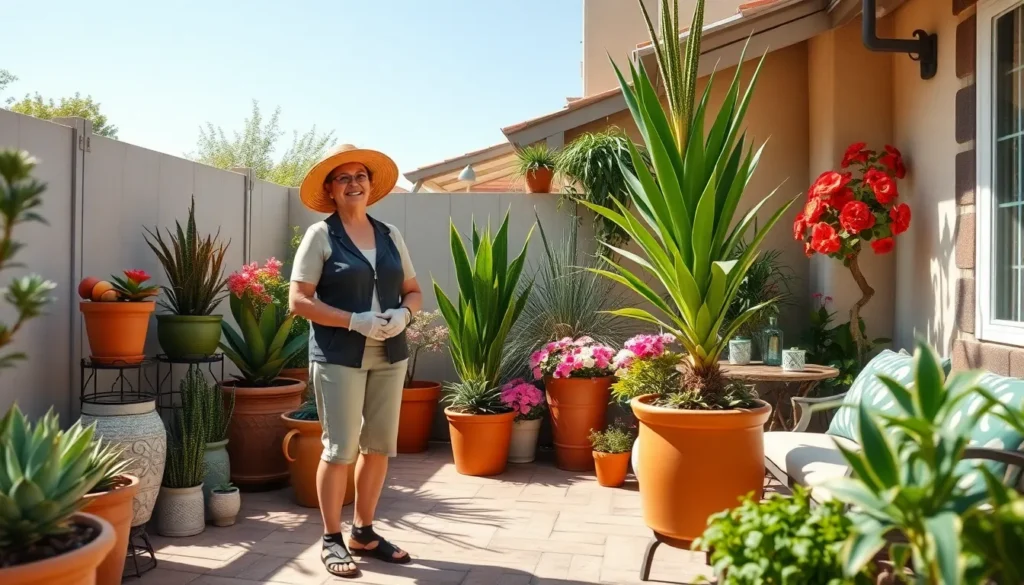Transforming your outdoor patio into a vibrant green sanctuary doesn’t require a massive garden or professional landscaping skills. Pot plants offer the perfect solution for creating stunning outdoor spaces that reflect your personal style while maximizing limited square footage.
We’ve discovered that container gardening on patios provides unmatched flexibility and creativity. You can easily rearrange plants based on seasons, sunlight patterns, or simply when you want a fresh new look. From colorful flowering annuals to dramatic foliage plants and even productive herb gardens, potted plants deliver maximum impact with minimal commitment.
Whether you’re working with a small apartment balcony or a spacious deck, we’ll show you how to select the right containers, choose plants that thrive in your exact conditions, and create eye-catching arrangements that’ll make your neighbors envious. Your dream patio oasis is just a few pots away.
Choose the Right Containers for Your Outdoor Patio Plants
We’ve covered the basics of transforming your patio space, and now it’s time to focus on selecting the perfect containers for your outdoor patio pot plants. Your container choice directly impacts plant health, growth, and overall patio aesthetics.
Consider Drainage Requirements
Drainage holes are absolutely essential for preventing root rot and maintaining healthy outdoor patio plants. We recommend containers with at least one hole per 12 inches of diameter, though multiple smaller holes work better than one large opening.
Proper drainage systems include:
- Multiple holes spaced evenly across the bottom
- Raised feet or saucers to elevate containers above standing water
- Gravel or pottery shards placed over drainage holes
- Well-draining potting mix designed for container gardening
Standing water kills more patio plants than drought conditions. We suggest testing drainage by filling your container with water and timing how quickly it empties completely.
Select Weather-Resistant Materials
Weather resistance determines how long your containers will last through seasonal changes and temperature extremes. We’ve found these materials perform best for outdoor patio environments:
| Material | Durability Rating | Temperature Range | Maintenance Level |
|---|---|---|---|
| Fiberglass | Excellent | -40°F to 120°F | Low |
| Ceramic (glazed) | Good | 20°F to 100°F | Medium |
| Resin/Plastic | Good | -20°F to 110°F | Low |
| Terra Cotta | Fair | 32°F to 95°F | High |
| Wood (treated) | Fair | -10°F to 100°F | High |
Fiberglass containers offer the best combination of durability and weather resistance for most climates. We avoid untreated wood and thin plastic containers that crack easily under temperature stress.
Determine Appropriate Size and Depth
Container size directly affects root development and plant stability in outdoor conditions. We calculate container needs based on mature plant size rather than current dimensions.
Size guidelines for common patio plants:
- Herbs like basil and oregano: 6-8 inches deep, 8-10 inches wide
- Flowering annuals such as petunias and marigolds: 8-12 inches deep, 12-16 inches wide
- Vegetables including tomatoes and peppers: 18-24 inches deep, 16-20 inches wide
- Small shrubs like boxwood and lavender: 20-30 inches deep, 24-36 inches wide
Larger containers retain moisture longer and provide better insulation for roots during temperature fluctuations. We always choose containers at least 2 inches larger than the plant’s root ball to allow for growth expansion.
Select Plants That Thrive in Containers on Patios
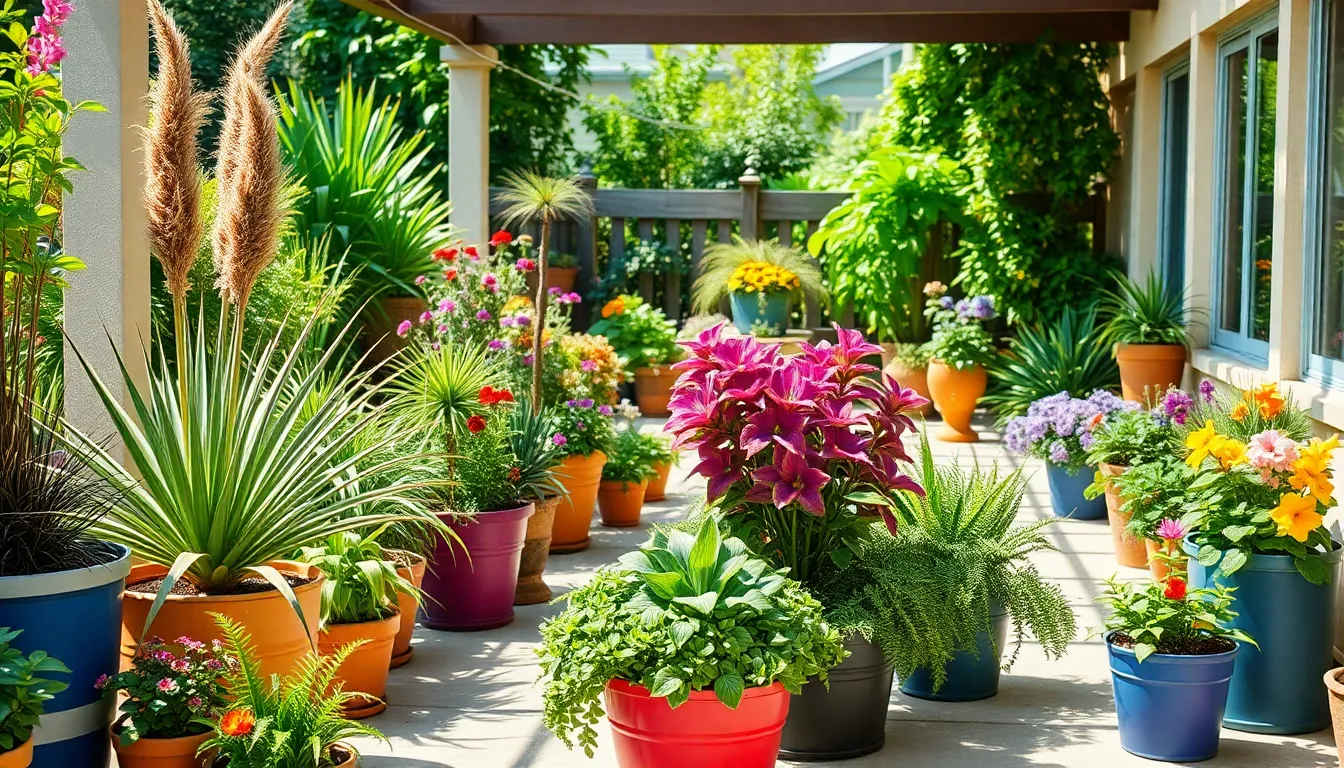
Now that you’ve chosen the perfect containers, we need to focus on selecting plants that actually flourish in the unique conditions of container growing. Container plants face different challenges than ground-planted varieties, so choosing species specifically adapted to pot life ensures our patio garden thrives year-round.
Pick Heat and Wind Tolerant Varieties
Patio environments create intense microclimates that demand resilient plant choices. Wind speeds increase around patios due to building structures, while concrete and stone surfaces reflect heat that can stress sensitive plants. We recommend selecting varieties like Yucca ‘Golden Sword’, which handles both extreme heat and dry conditions with remarkable durability.
Japanese pieris (Pieris japonica) offers another excellent heat-tolerant option that provides evergreen structure throughout the seasons. This hardy shrub adapts to various light conditions while resisting deer damage, though we should position it away from harsh winter winds and intense afternoon sun for optimal performance.
Butterfly Bush thrives in full sun patio conditions and attracts pollinators, making it both beautiful and functional. These robust selections create the foundation for a patio garden that withstands challenging outdoor conditions without constant intervention.
Choose Plants Based on Sunlight Exposure
Matching plants to your patio’s exact light conditions determines success or failure in container gardening. Full sun patios receive six or more hours of direct sunlight daily, creating perfect conditions for sun-loving varieties like Verbena and Celosia, which produce abundant blooms in bright locations.
Partial shade areas work beautifully with Golden creeping Jenny (Lysimachia nummularia ‘Aurea’), which cascades elegantly over container edges while tolerating various light levels. This versatile plant prefers partial shade but adapts to full sun when we provide adequate moisture.
Low light patios benefit from shade-tolerant champions like Hosta and Heuchera varieties, which offer stunning foliage colors and textures without requiring intense sunlight. These plants create lush, garden-like appearances even in challenging darker spaces.
Consider Seasonal Interest and Bloom Times
Strategic plant selection ensures our patio containers look attractive throughout multiple seasons rather than just brief flowering periods. Japanese pieris provides year-round evergreen foliage while delivering spectacular spring displays with colorful new growth and showy winter buds that add interest during dormant months.
Summer performers like Celosia and Verbena peak during hot weather, filling containers with vibrant colors when many other plants struggle. These heat-lovers complement spring bloomers by extending the flowering season into late summer.
Fall transitions benefit from plants like asters and Golden creeping Jenny, which maintain visual appeal as temperatures drop and summer annuals fade. Boxwoods retain their color throughout winter, providing structural backbone when deciduous plants go dormant.
By layering plants with different peak seasons, we create container displays that evolve and maintain interest across the entire growing year rather than looking spectacular for just a few weeks.
Plan Your Patio Layout for Maximum Impact
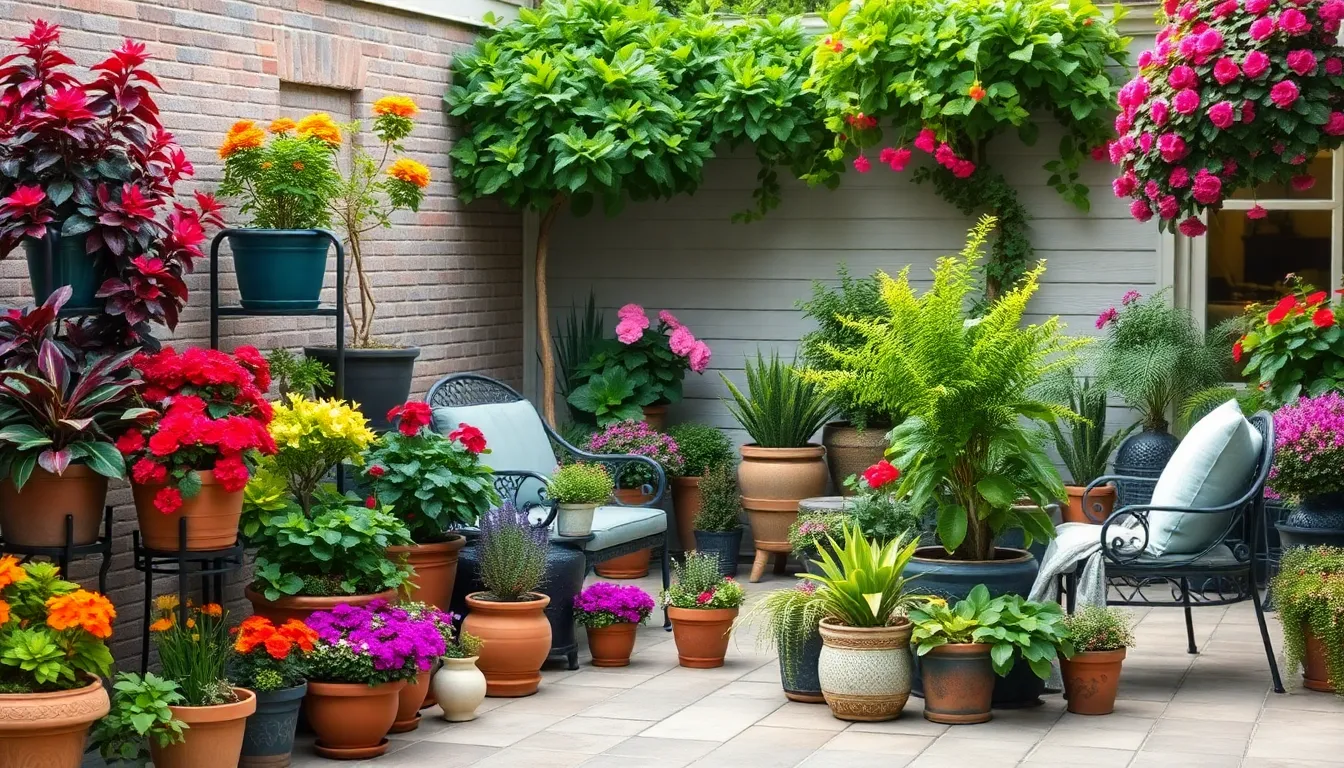
Now that we’ve selected the perfect containers and plants for our outdoor space, it’s time to arrange them strategically. Thoughtful layout planning transforms a collection of potted plants into a cohesive, functional patio design that maximizes both visual appeal and practical use.
Create Height Variations with Plant Stands
Vertical interest becomes essential when we’re working with container gardens on flat patio surfaces. Plant stands and varying pot sizes help us create ever-changing layers that draw the eye upward and make our space feel larger.
Elevated positioning serves multiple purposes beyond aesthetics. Taller plants or raised containers naturally become focal points while providing privacy screens when positioned strategically. We can use plant stands to lift smaller specimens to eye level, ensuring they don’t get lost among larger floor containers.
Anchoring elements like Japanese maples or small ornamental trees in substantial pots provide structure to our overall design. These larger specimens define different areas of the patio and create natural boundaries between seating areas and walkways.
Dimensional layering works best when we combine plants at three distinct levels: ground level containers, mid height stands, and tall specimens. This approach ensures every plant gets noticed while creating depth that makes our patio feel professionally designed.
Group Plants by Water and Light Needs
Smart plant grouping simplifies maintenance while improving the health of our container garden. When we cluster plants with similar requirements together, we avoid the common mistake of overwatering drought tolerant species or underwatering thirsty plants.
Watering zones make our maintenance routine more efficient and effective. Sun loving succulents thrive when grouped in sunny corners where we can water them sparingly, while moisture loving ferns perform better when clustered in shadier spots with consistent watering schedules.
Light requirement clustering prevents plant stress and ensures optimal growth. Full sun plants like Mediterranean herbs benefit from being positioned together in the brightest areas, while shade tolerant hostas and begonias can be grouped in areas that receive morning sun but afternoon shade.
Microclimate creation happens naturally when we group plants with similar needs. These clusters develop their own growing conditions that support all plants in the group, reducing individual plant stress and creating more successful container displays.
Design Focal Points and Visual Flow
Strategic focal points guide visitors through our patio space while creating memorable visual experiences. We achieve this by combining striking plants with thoughtful positioning and design elements that enhance the overall flow.
Container combinations featuring perennials, annuals, and ornamental grasses create stunning centerpiece displays. These mixed plantings provide seasonal color changes while maintaining structure through the growing season, ensuring our patio remains attractive from spring through fall.
Vertical elements like trellises with climbing vines add privacy while drawing attention upward. These living screens serve dual purposes by creating intimate seating areas and providing backdrop interest that enhances our overall plant display.
Color and texture repetition throughout the space creates visual cohesion that ties everything together. We use similar colors in different areas and repeat textures and plant shapes to establish rhythm that makes our patio feel intentionally designed rather than randomly planted.
Traffic flow consideration ensures our beautiful plant arrangements don’t interfere with practical patio use. Strategic placement allows easy movement between seating areas while ensuring plants enhance rather than obstruct the natural pathways people take through our outdoor space.
Prepare Quality Potting Mix for Container Success
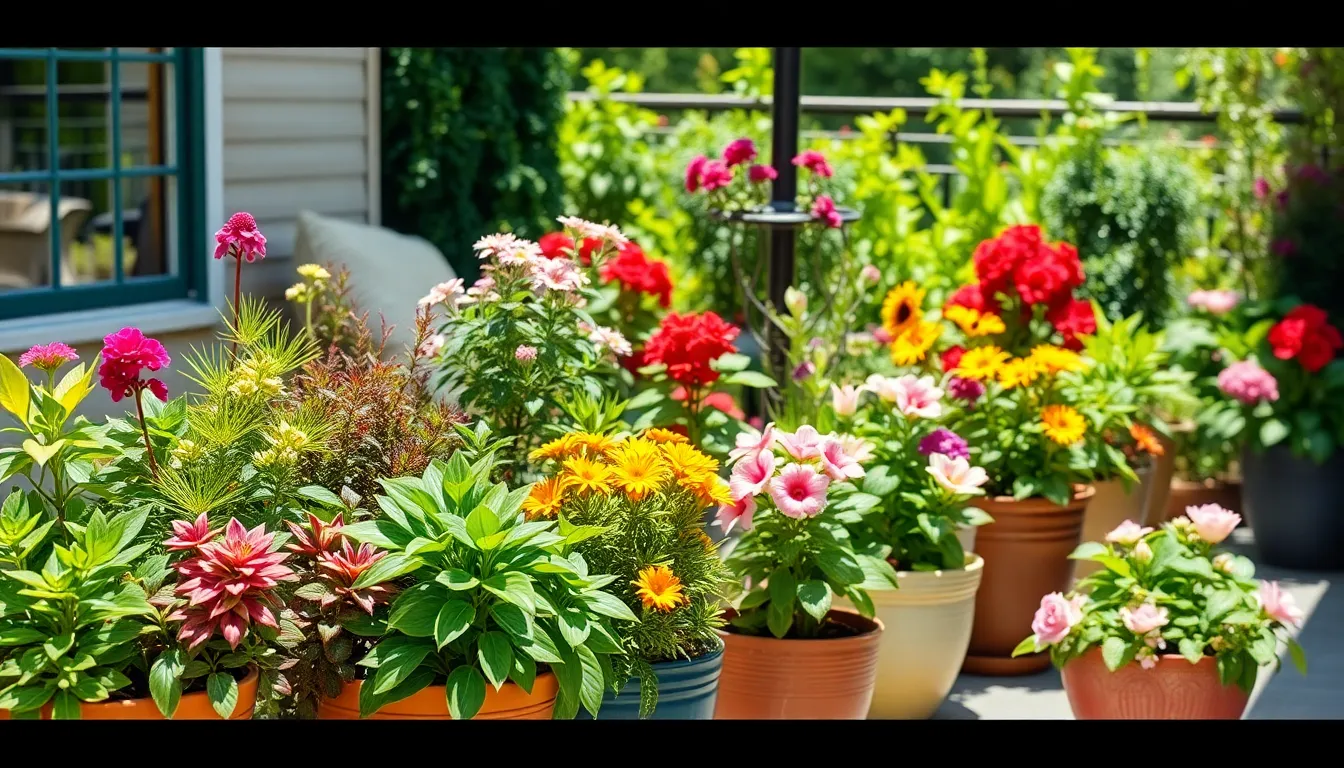
Now that we’ve selected our containers and planned our layout, we need to focus on creating the foundation for healthy plant growth through proper soil preparation.
Use Well-Draining Soil Blends
Choose container-exact potting mixes designed for outdoor use to ensure your patio plants receive adequate oxygen and drainage. Standard garden soil becomes too dense and heavy in containers, creating waterlogged conditions that suffocate plant roots and prevent proper aeration.
Test your potting mix’s drainage by watering thoroughly and observing how quickly excess water flows from the drainage holes. Quality blends should allow water to move freely while retaining enough moisture for plant needs.
Look for lightweight formulations that contain materials like perlite, vermiculite, or bark chips to maintain proper soil structure in containers. These components prevent compaction over time and ensure consistent airflow to root systems throughout the growing season.
Add Organic Matter and Fertilizers
Mix slow-release granular fertilizer into your potting blend at planting time to provide steady nutrition over several months. Container plants require more frequent feeding than ground-planted varieties because nutrients wash away more quickly through drainage.
Incorporate organic matter such as compost or peat moss to improve the soil’s moisture retention and nutrient content. This addition creates a more balanced growing environment that supports robust root development and plant health.
Apply liquid water-soluble fertilizers every two to three weeks during the growing season, diluting them to half strength to prevent root burn. Container plants have higher nutrient demands due to their confined growing space and frequent watering requirements.
Refresh your container soil each spring by removing the top few inches and replacing it with fresh compost mixed with slow-release fertilizer granules. Top with mulch to retain moisture and protect roots from temperature fluctuations.
Avoid Garden Soil in Containers
Skip using garden soil directly in your patio containers, as it often contains pests, diseases, and lacks the proper structure needed for container gardening success. Garden soil’s heavy composition restricts drainage and root growth in confined spaces.
Understand the density difference between garden soil and container mixes, as regular soil becomes compacted in pots and creates anaerobic conditions that harm plant roots. This compaction prevents water infiltration and air circulation that containerized plants require.
Recognize contamination risks when using garden soil, including weed seeds, fungal spores, and insect larvae that can quickly overwhelm container plants in their confined environment. Commercial potting mixes undergo sterilization processes that eliminate these potential problems.
Install Proper Watering Systems for Patio Plants
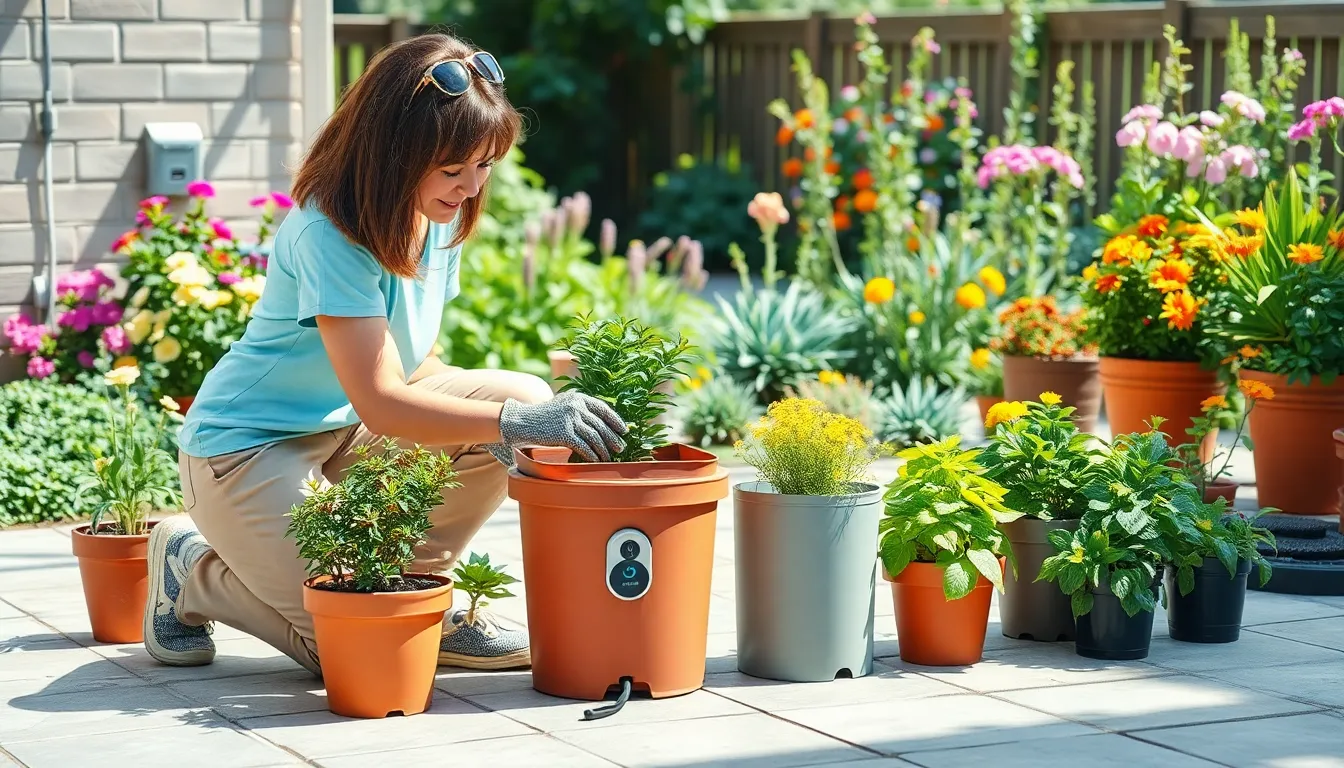
Water management becomes critical when we’re working with containers on patios since potted plants dry out faster than those in the ground. Proper irrigation systems ensure our plants receive consistent moisture directly to their roots while minimizing waste and promoting healthy growth.
Set Up Drip Irrigation for Consistency
Drip irrigation systems deliver water slowly and precisely to each plant’s root zone through a network of tubes and emitters. This microirrigation method reduces water loss from evaporation by up to 50% compared to traditional sprinkler systems. We recommend installing adjustable drip emitters that allow us to customize water flow rates for different plant types and container sizes.
Most drip systems can be connected to existing outdoor faucets using pressure regulators and timers for automated operation. The tubing runs along the patio surface or can be concealed beneath decorative mulch or stones. Emitters should be positioned to water the soil surface rather than plant foliage to prevent fungal diseases and maximize water efficiency.
Use Self-Watering Containers
Self-watering containers feature built-in water reservoirs that supply plants with steady moisture through capillary action. These specialized pots include a water tank at the bottom that slowly releases moisture upward into the soil as needed. The system maintains consistent soil moisture levels and reduces our watering frequency by 2-3 times compared to standard containers.
We find these containers particularly valuable in sunny or windy patio environments where plants experience rapid moisture loss. The reservoir typically holds enough water for 3-7 days depending on plant size and weather conditions. Many self-watering systems include water level indicators that show when refilling is needed.
Establish Daily Watering Routines
Daily moisture monitoring helps us maintain optimal growing conditions even with automated systems in place. We check soil moisture levels by inserting our finger 1-2 inches into the potting mix each morning. Plants typically need water when the top inch of soil feels dry to the touch.
Weather conditions significantly impact watering schedules since hot, windy days increase water needs while cool, humid conditions reduce them. We adjust our watering frequency based on temperature, humidity, and rainfall patterns. Automated systems with moisture sensors can activate watering only when soil moisture drops below preset thresholds, conserving water while ensuring plants receive adequate hydration.
Protect Plants from Harsh Weather Conditions
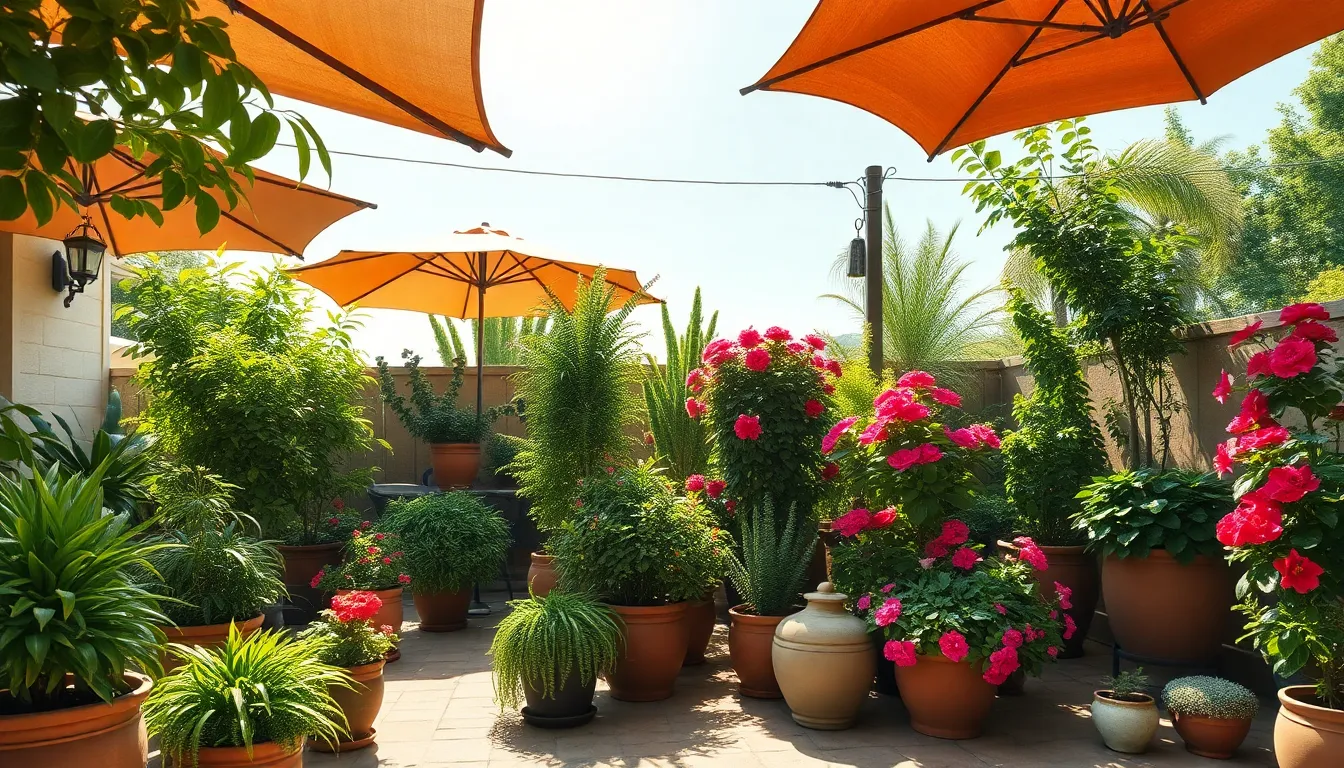
Weather conditions on outdoor patios create unique challenges that require proactive protection strategies. We’ll share proven methods to safeguard your container plants from harsh elements while maintaining their health and beauty.
Shield from Strong Winds and Storms
Position pots in sheltered corners or against walls that naturally block strong gusts to create wind barriers. Heavy containers resist tipping better than lightweight options during severe weather events. Stakes, posts, or wire supports placed inside or around containers provide additional stability without damaging plant foliage.
During storm warnings, we recommend moving lightweight plants indoors temporarily. Creating windbreaks using screens or temporary barriers helps protect multiple plants simultaneously. Grouping containers together forms natural wind protection where individual plants shield each other from harsh gusts.
Provide Shade During Extreme Heat
Move potted plants to naturally shaded areas like north-facing walls or beneath trees during extreme heat periods. Shade cloths offering 30% to 50% sun protection work effectively when supported on poles above plants without touching foliage. Temporary shade structures including umbrellas provide quick relief during unexpected heat waves.
Mulching soil inside containers keeps roots cooler and retains essential moisture during hot weather. Water plants deeply in early morning hours before heat waves arrive to prepare them for challenging conditions. Regular monitoring helps identify heat stress symptoms before permanent damage occurs.
Move Tender Plants Indoors When Necessary
Relocate cold-sensitive plants indoors or to protected environments when frost threatens your patio garden. Borderline hardy plants benefit from pot insulation using materials like blankets, burlap, or bubble wrap around containers. Partially burying pots in trenches utilizes natural soil insulation to protect root systems from freezing temperatures.
Top containers with mulch to maintain warmth and moisture around plant roots during cold snaps. Stakes or PVC pipes lift frost covers off plant foliage to prevent contact damage while maintaining protection. Keep soil consistently moist but avoid waterlogging since dry soil increases cold injury risk for container plants.
Maintain Healthy Growth Throughout the Seasons
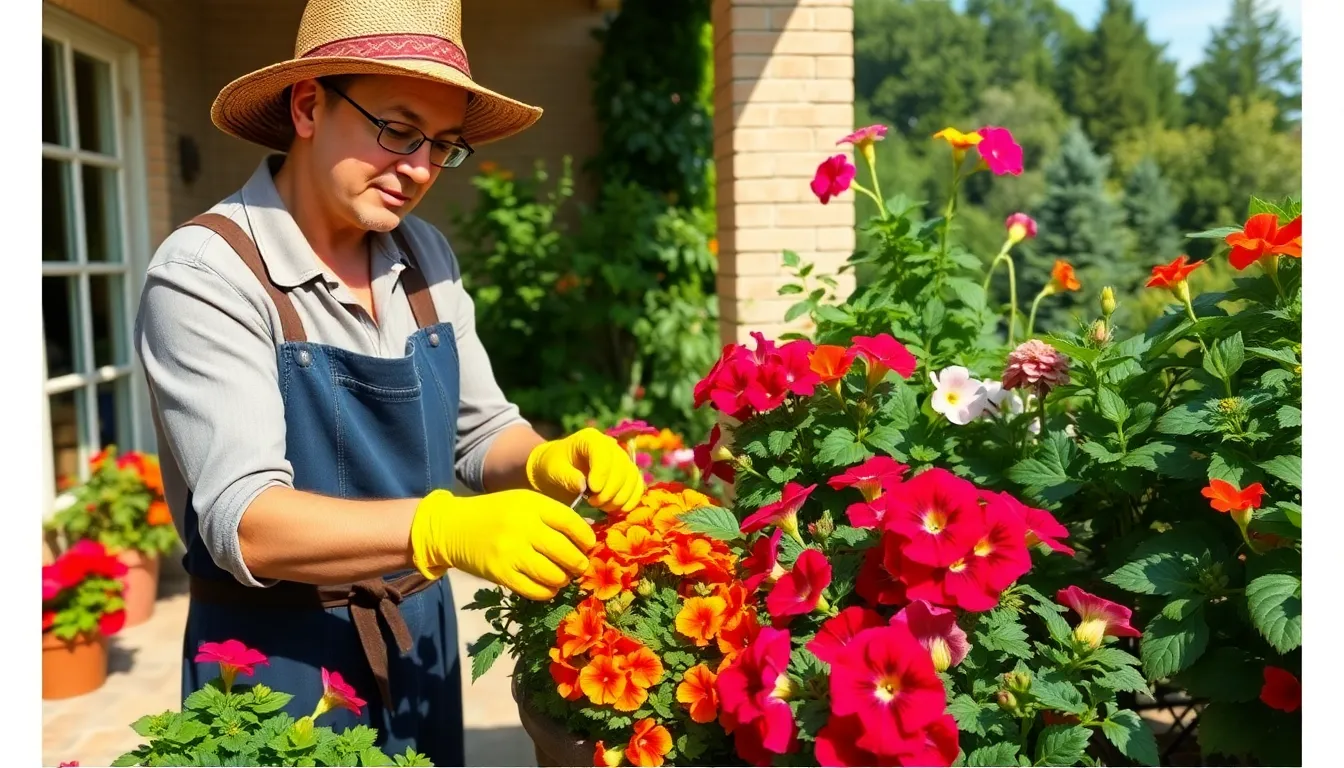
Seasonal care routines keep our patio plants thriving year-round while adapting to changing weather conditions. Our container gardens require consistent attention to pruning, pest management, and feeding schedules that support optimal plant health.
Prune and Deadhead Regularly
Regular pruning encourages new growth and maintains attractive plant shapes throughout the growing season. We recommend deadheading spent flowers frequently to promote continuous blooming, especially in flowering plants like geraniums and petunias that benefit from weekly maintenance.
Trimming healthy blooms about once per week keeps our plants neat and productive. Summer months require more frequent deadheading sessions as plants reach peak flowering periods. Sharp, clean pruning shears prevent disease transmission between plants while ensuring clean cuts that heal quickly.
Weekly maintenance sessions also provide opportunities to remove yellowing leaves and weak stems. Plants redirect energy toward healthy growth when we eliminate dying or damaged parts regularly.
Monitor for Pests and Diseases
Keeping an eye on foliage moisture helps prevent fungal infections that commonly affect container plants. We avoid watering late in the day to prevent wet leaves which create ideal conditions for disease development.
Removing weeds promptly from containers eliminates competition for nutrients and moisture while reducing pest hiding spots. Container environments can harbor aphids, spider mites, and whiteflies that spread quickly in enclosed growing spaces.
Pruning dead or diseased parts immediately prevents problems from spreading to healthy plant sections. Early morning inspections help us catch issues before they become serious threats to our patio garden’s health.
Fertilize According to Plant Needs
Container plants consume nutrients rapidly due to limited soil volume compared to ground-planted specimens. We incorporate balanced slow-release fertilizer into our potting mix at planting time to provide steady nutrition throughout the growing season.
Supplementing with water-soluble fertilizer about one month after planting supports vigorous growth during peak summer months. Applications every 1-2 weeks at half strength prevent root burning while delivering adequate nutrition to our plants.
Adjusting fertilizer type and frequency based on plant species ensures optimal nutrition without waste. Succulents need less frequent feeding than flowering annuals, while leafy vegetables require higher nitrogen levels for productive harvests.
Create Year-Round Interest with Strategic Plant Choices
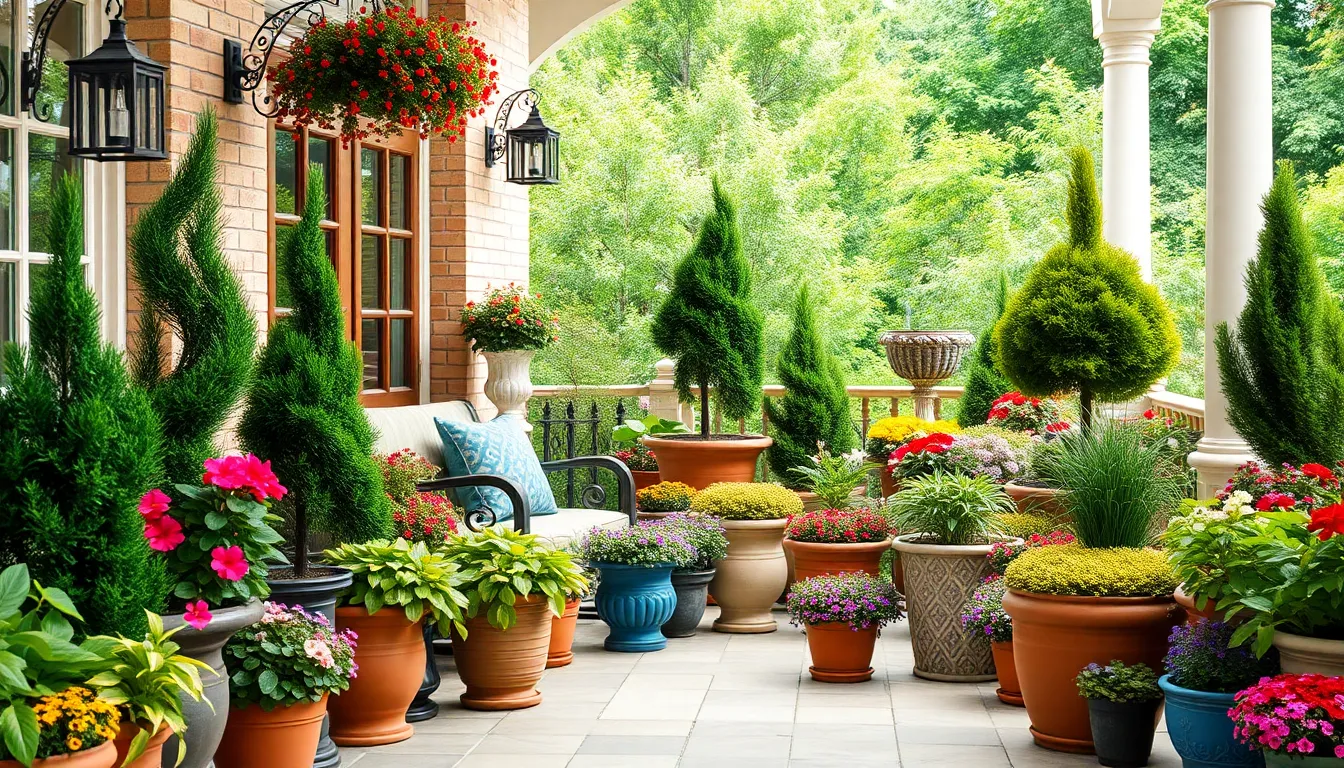
We recommend combining plants with different textures, colors, and growth habits to maintain visual appeal across all seasons. Strategic selection ensures your patio remains vibrant whether it’s summer or winter.
Incorporate Evergreen Plants for Structure
Evergreen plants provide the backbone of successful container arrangements by maintaining consistent greenery throughout dormant periods. Dwarf English Boxwood stands out as an exceptional choice because it tolerates cold conditions while preserving lush foliage year round. We’ve found that cypress topiaries and yews create elegant structural elements that define container shapes even during harsh winter months.
Blue Spruce and Emerald Arborvitae offer excellent alternatives for gardeners seeking dwarf conifer options. These varieties provide reliable winter interest while requiring minimal maintenance. Container grown evergreens serve as anchor points that make patios feel inviting regardless of weather conditions.
Add Seasonal Color with Annuals
Annual plants deliver dramatic color shifts that transform your container displays throughout the growing seasons. Ornamental kale and winter heather brighten cold weather displays when most flowering plants enter dormancy periods. We suggest positioning tall thriller plants like Agastache or Salvia in container centers to create impressive vertical elements.
Medium height filler plants such as Penstemon and ornamental grasses work perfectly around thriller centerpieces. Low spill plants cascading over container edges soften harsh lines while adding movement to arrangements. This three tier approach creates professional looking displays that capture attention from multiple viewing angles.
Include Herbs and Edible Plants
Herbs and small fruit varieties add functional beauty while providing fresh ingredients for cooking projects. Rosemary and thyme thrive in pot environments because they’re naturally hardy and drought tolerant once established. We recommend these Mediterranean herbs for beginning container gardeners since they forgive occasional watering mistakes.
Compact fruit trees and berry bushes contribute seasonal interest through changing foliage colors and flowering cycles. These edible additions create conversation starters while serving practical purposes in outdoor kitchens. Container friendly fruit varieties often produce surprising yields in relatively small growing spaces.
Troubleshoot Common Patio Container Problems
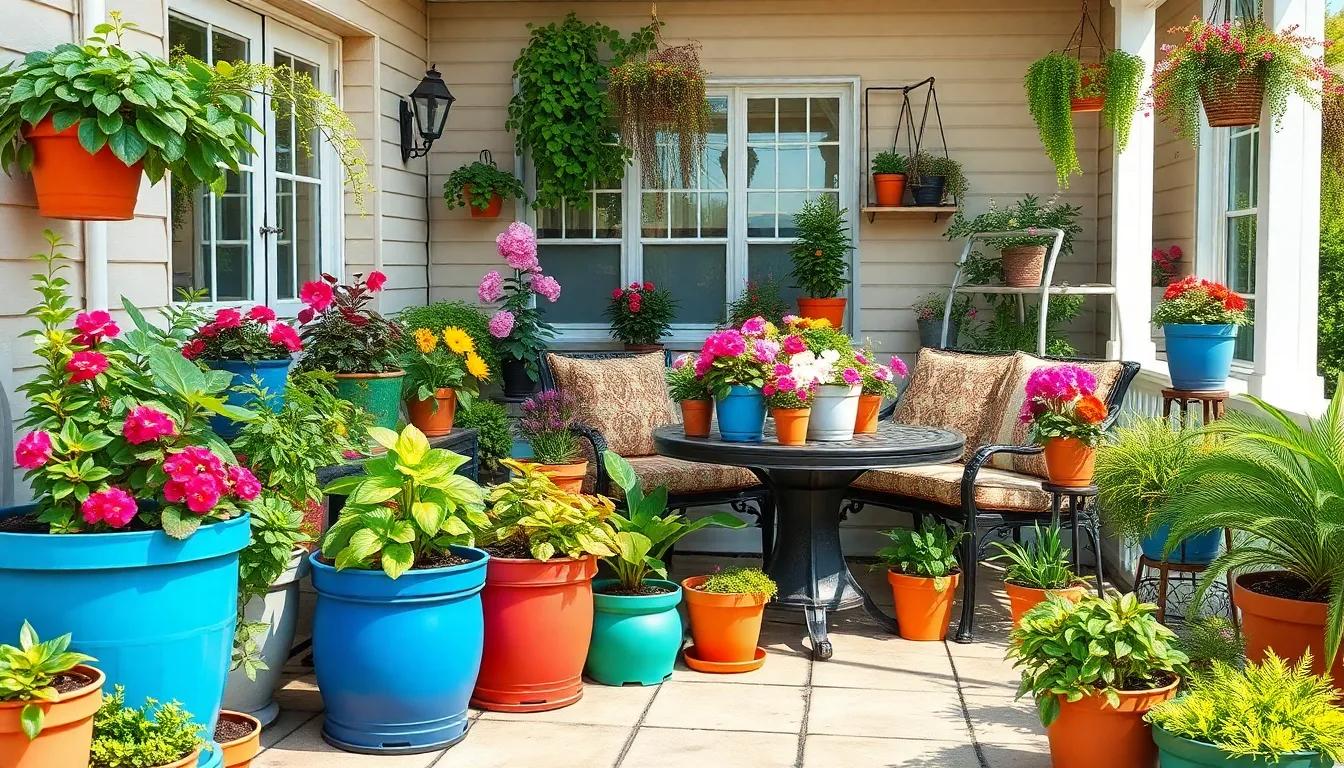
Even with careful planning and preparation, our patio container gardens can develop issues that affect plant health and appearance. Identifying and solving these common problems quickly helps maintain thriving outdoor pot displays.
Address Root Bound Plants
Root bound conditions develop when plant roots outgrow their container space, creating densely packed root systems that circle inside the pot. This restriction limits nutrient and water uptake, resulting in poor growth and stunted development.
Repotting provides the most effective solution by moving plants into larger containers that give roots adequate space to expand. Pruning circling roots before transplanting helps redirect growth patterns and prevents future binding issues. Refreshing soil with nutrient rich potting mix during repotting ensures plants receive proper aeration, since garden soil becomes too heavy and limits oxygen flow in containers.
Fix Drainage and Overwatering Issues
Proper drainage prevents root rot caused by standing water accumulation in container bottoms. Poor water management creates the most common cause of patio plant failure.
Ensuring containers have adequate drainage holes allows excess water to escape effectively. Using well draining organic potting mix prevents waterlogging that suffocates root systems. Watering thoroughly when the top 2 to 3 inches of soil feel dry maintains proper moisture without creating soggy conditions.
Removing excess water from saucers prevents salt buildup, root rot development, and mosquito breeding opportunities. Watering until drainage appears from container bottoms ensures deep root moisture penetration. Avoiding late day watering reduces foliar disease risks that develop in humid nighttime conditions.
Handle Temperature Stress Symptoms
Outdoor potted plants face temperature fluctuations that stress both root systems and foliage more severely than ground planted specimens. Container growing exposes roots to rapid temperature changes that affect plant performance.
Increasing watering frequency to daily schedules during hot weather compensates for rapid moisture loss in sun and heat exposed pots. Reducing watering frequency during cooler seasons while preventing complete soil drying maintains healthy root conditions year round.
Protecting containers from freezing temperatures requires moving pots to sheltered locations during winter months. Insulating with burlap wraps or foam sleeves provides additional root protection during cold snaps. Adding mulch to soil surfaces creates an insulating layer that protects root zones from temperature extremes.
Conclusion
Creating a stunning outdoor patio garden with pot plants doesn’t require extensive gardening experience or a massive budget. With the right containers proper soil preparation and strategic plant selection we can transform any patio space into a thriving green oasis.
The key lies in understanding our exact growing conditions and choosing plants that’ll flourish in containers. By implementing proper watering systems seasonal care routines and weather protection strategies we’ll ensure our patio garden remains beautiful and healthy year-round.
Remember that container gardening offers incredible flexibility – we can rearrange plants experiment with different combinations and adapt our space as our preferences change. Start small build confidence and gradually expand your collection as you discover what works best in your unique outdoor environment.
Frequently Asked Questions
What are the main benefits of container gardening on a patio?
Container gardening offers flexibility in plant arrangement, requires minimal landscaping skills, and works for any space size. You can easily move plants to optimize growing conditions, create attractive displays with less effort than traditional gardens, and transform any patio into a green oasis regardless of your gardening experience level.
How do I choose the right containers for my patio plants?
Select containers with drainage holes to prevent root rot and choose weather-resistant materials like fiberglass for durability. Larger containers are better as they retain moisture longer and insulate roots. Test drainage efficiency by ensuring water flows freely through the bottom holes before planting.
What types of plants work best in patio containers?
Choose heat and wind-tolerant varieties like Yucca ‘Golden Sword’ and Japanese pieris that can handle patio microclimates. Match plants to your specific sunlight conditions and select a mix of species that bloom in different seasons to ensure year-round visual interest and continuous color.
How should I arrange my container plants for maximum impact?
Use plant stands and varying pot sizes to create height variations and visual appeal. Group plants by similar water and light needs for easier maintenance. Create focal points with striking plants and ensure good traffic flow while positioning containers to provide privacy and guide visitors through the space.
What type of soil should I use for patio container plants?
Use well-draining potting mix specifically designed for outdoor containers, never standard garden soil which becomes waterlogged. Incorporate organic matter and slow-release fertilizers to enhance moisture retention and nutrients. Refresh container soil each spring to maintain optimal growing conditions and prevent pest issues.
How often should I water my patio container plants?
Potted plants dry out faster than ground plants, so establish daily watering routines and monitor soil moisture regularly. Consider installing drip irrigation systems or using self-watering containers for consistent moisture delivery. Adjust watering frequency based on weather conditions, increasing during hot, windy periods.
How can I protect my container plants from harsh weather?
Position pots in sheltered areas and use heavy containers for wind stability. Move lightweight plants indoors during severe weather and create windbreaks for protection. For extreme heat, relocate plants to shade and use mulch. Move cold-sensitive plants indoors during frost and insulate pots in winter.
What seasonal care do patio container plants need?
Perform regular pruning and deadheading to encourage new growth and continuous blooming. Monitor for pests and diseases for early detection and management. Use slow-release fertilizers and water-soluble options tailored to specific plant needs. Adjust care routines based on seasonal weather changes and plant requirements.
How can I maintain year-round interest in my patio garden?
Combine plants with different textures, colors, and growth habits. Include evergreens like Dwarf English Boxwood for structure and add seasonal color with annuals such as ornamental kale. Consider incorporating herbs and small fruit varieties for functional beauty while providing fresh ingredients for cooking.
What are common problems with patio container gardens and their solutions?
Root-bound plants need repotting into larger containers. Ensure proper drainage to prevent root rot by checking and clearing drainage holes. Address temperature stress by adjusting watering practices and moving plants to appropriate locations. Regular monitoring and prompt action help maintain healthy, thriving outdoor displays.

